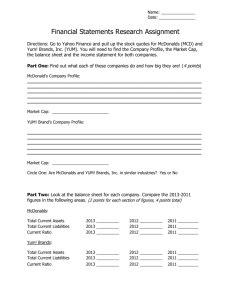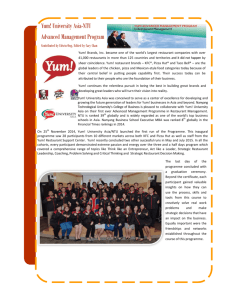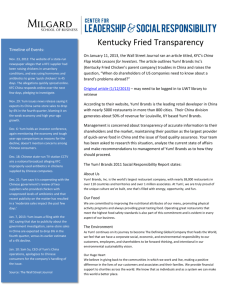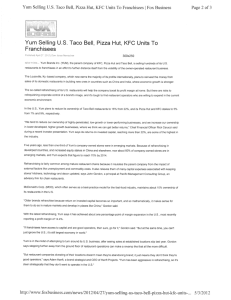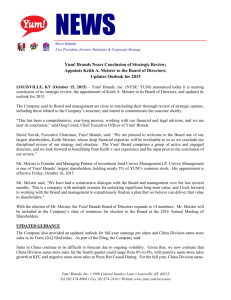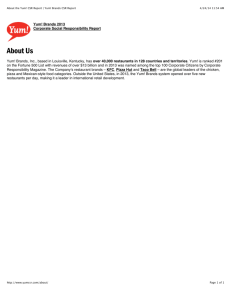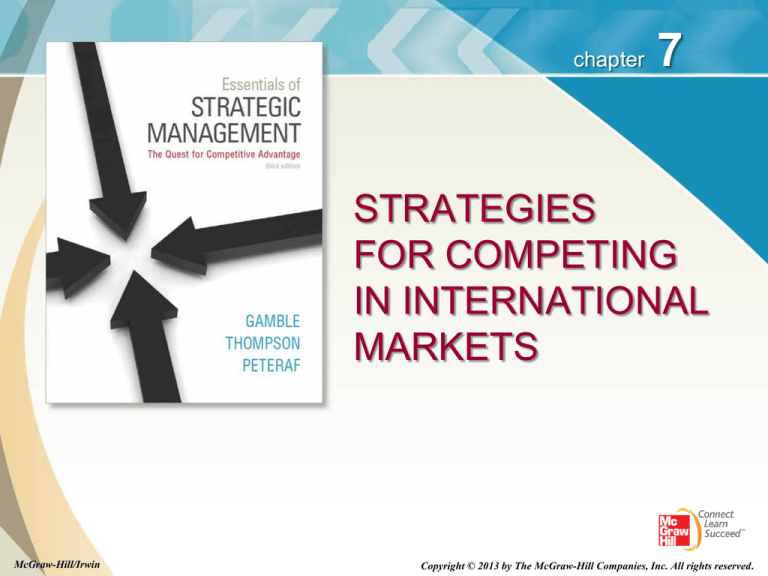
chapter
7
STRATEGIES
FOR COMPETING
IN INTERNATIONAL
MARKETS
McGraw-Hill/Irwin
Copyright © 2013 by The McGraw-Hill Companies, Inc. All rights reserved.
LO1 Develop an understanding of the primary
reasons companies choose to compete in
international markets.
LO2 Learn why and how differing market conditions
across countries influence a company’s
strategy choices in international markets.
LO3 Gain familiarity with the five general modes of
entry into foreign markets.
LO4 Learn the three main options for tailoring a
company’s international strategy to crosscountry differences in market conditions and
buyer preferences.
7-2
(cont’d)
LO5 Understand how multinational companies are
able to use international operations to improve
overall competitiveness.
LO6 Gain an understanding of the unique
characteristics of competing in developingcountry markets.
7-3
Why Companies Expand into
International Markets
1. To gain access to new customers
2. To achieve lower costs and enhance the
firm’s competitiveness
3. To further exploit its core competencies
4. To gain access to resources and
capabilities located in foreign markets
5. To spread its business risk across a wider
market base
7-4
Factors That Shape Strategy Choices
in International Markets
1. The degree to which there are important country
differences in buyer tastes, market sizes, and
growth potential
2. Whether opportunities exist to gain a locationspecific advantage based on wage rates, worker
productivity, inflation rates, energy costs, tax
rates, and other factors that impact cost structure
3. The risks of adverse shifts in currency exchange
rates
4. The extent to which governmental policies affect
the business environment
7-5
Country Differences in Buyer Tastes, Market
Sizes, and Growth Potential
Differences
in local buyer tastes
Raise manufacturing and distribution costs
Reduce scale economies and learning curve effects
Differences
in market growth potential
Demographics, income levels, and cultural
attitudes vary widely in emerging markets
Lack of infrastructure, distribution systems,
and retail networks limits market growth
Differences
in the intensity of local competition
7-6
How Market Demographics Differ
from Country to Country
Distribution channel
emphasis
Consumer tastes
and preferences
Consumer
purchasing power
Consumer
buying habits
Demographic
Differences
Demands for
localized products
Strength of local
competitive rivalry
7-7
How Market Demographics Differ
from Country to Country
Consumer
tastes and preferences
Consumer
purchasing power
Consumer
buying habits
Distribution
Demands
Strength
channel emphasis
for localized products
of local competitive rivalry
7-8
Opportunities for Location-Based
Cost Advantages
Wage
rates
Worker
productivity
Environmental
regulations
Location-Based
Cost Advantages
Energy
costs
Tax
rates
Inflation
rates
Industry
subsidies
7-9
Opportunities for Location-Based
Cost Advantages
A
firm’s costs and profitability are impacted
by the location of its activities due to:
Wage rates
Worker productivity
Energy costs
Environmental regulations
Tax rates
Inflation rates
Industry subsidies
7-10
Changing Exchange Rates
Rate
Japan Y
150:1 1,500,000
125:1 1,250,000
100:1 1,000,000
U. S. $
10,000
10,000
10,000
125:1
100:1
16,000
20,000
2,000,000
2,000,000
The Risks of Adverse
Exchange Rate Shifts
Exporters
gain in competitiveness when the
currency of the country in which the goods
are manufactured is weak relative to the
currency of the country to which the goods
are to be exported.
Exporters are at a disadvantage when the
currency of the country where goods are
manufactured grows stronger relative to the
country to which the goods are to be
exported.
7-12
The Impact of Host-Government Policies
on the Local Business Climate
Host-government
policies that create a
business climate favorable to foreign firms
agreeing to construct or expand production
and distribution facilities in the host country
include:
Reduced taxes
Low-cost loans
Site-development assistance
7-13
The Impact of Host-Government Policies
on the Local Business Climate (cont’d)
Limits on repatriation
of local funds
Environmental
regulations
Customs requirements,
tariffs and quotas
Negative impact
of government
policies
Local content
requirements
Local ownership or
partner requirements
Subsidies for
domestic companies
Requiring prior approval of
capital spending projects
7-14
The Impact of Host-Government Policies
on the Local Business Climate (cont’d)
Host-government
policies negatively
affecting foreign-based firms include:
Environmental regulations
Customs requirements, tariffs, and quotas
Local content requirements
Requiring prior approval of capital spending projects
Limits on repatriation of local funds
Local ownership or partner requirements
Subsidies for domestic companies
7-15
Core Concept
Political risks stem from instability or weakness in national governments and hostility to
foreign business; economic risks stem from
the instability of a country’s monetary system,
changes in economic and regulatory policies,
and the lack of property rights protections.
7-16
Strategy Options for Entering
Foreign Markets
1. Maintain a national (one-country) production
base and export goods to foreign markets.
2. License foreign firms to produce and distribute
the company’s products.
3. Employ a franchising strategy.
4. Establish a subsidiary in a foreign market.
5. Rely on strategic alliances or joint ventures with
foreign partners to enter new country markets.
7-17
Export Strategies
Exporting involves using domestic plants as a
production base for exporting to foreign markets.
Advantages:
Conservative way to test international waters
Minimizes both risk and capital requirements
An export strategy is vulnerable when:
Manufacturing costs in the home country are higher than
in foreign countries where rivals have plants.
The costs of shipping the product to distant markets
are relatively high.
Adverse shifts can occur in currency exchange rates.
7-18
Licensing Strategies
Licensing
makes sense when a firm:
Has valuable technical know-how or a patented
product but has neither the internal capabilities nor
resources to enter foreign markets.
Wants to avoid the risks of committing resources to
country markets that are unfamiliar, politically volatile,
economically unstable, or otherwise risky.
Seeks to generate income from potential royalties.
Disadvantage
of licensing:
Providing technical know-how to foreign firms creates
risks and difficulty in maintaining control over its use.
7-19
Franchising Strategies
Often
better suited to the global expansion
efforts of service and retailing enterprises
Advantages:
Franchisee bears many of the costs and risks
of establishing foreign locations
Franchisor has to expend only the resources
to recruit, train, and support franchisees
Disadvantage:
Maintaining cross-border quality control
Allowing franchisees discretion in adapting
to local preferences and tastes
7-20
Establishing a Subsidiary
in a Foreign Market
Allows
for direct control over all aspects
of operating in a foreign market.
Options
for developing a subsidiary:
Acquiring either a struggling or successful foreign
local firm is the most feasible and direct path to
overcoming market-specific entry barriers.
Establishing a foreign subsidiary from the ground up
via internal development is based on the firm’s prior
experience with foreign market operations.
7-21
Developing a Wholly Owned Start-up
Subsidiary in a Foreign Market
An internal start-up strategy is appealing when:
Creating an internal start-up is cheaper than making
an acquisition.
Adding new production capacity will not adversely impact
the supply–demand balance in the local market.
A start-up subsidiary can gain good distribution access (perhaps
because of the firm’s recognized brand name).
A start-up subsidiary will have the size, cost structure, and
resources to compete head-to-head against local rivals.
7-22
Using International Strategic Alliances
and Joint Ventures to Build Competitive
Strength in Foreign Markets
Mutual Benefits of Cross-Border Alliances:
Facilitation of entry into foreign markets
Strengthening of a firm’s competitiveness in world markets
Capturing of economies of scale in production and marketing
Filling of gaps in technical expertise and local market knowledge
Sharing of distribution facilities, dealer networks, and mutual
access to customers
Attacking of mutual rivals and providing for mutual assistance
Building of working relationships with local political and host-
country governmental entities
Gaining of agreements on technical and process standards
7-23
Using International Strategic Alliances
and Joint Ventures to Build Competitive
Strength in Foreign Markets (cont’d)
Individual Partner Benefits of Alliances:
Preservation of each partner firm’s independence
Avoidance of the firm’s use of scarce financial resources
to fund acquisitions
Retention of the firm’s flexibility to readily disengage
once the purpose of the alliance has been served
Option to withdraw from the alliance if its benefits prove elusive
to the more permanent arrangement required by an acquisition
7-24
Concepts and Connections 7.1
Examples of Cross-Border Strategic Alliances
1. Verio, a subsidiary of Japan-based NTT
Communications and one of the leading global
providers of Web hosting services and IP data
transport, has developed an alliance-oriented
business model that combines the company’s
core competencies with the skills and products of
best-of-breed technology partners. Verio’s
strategic partners include Arsenal Digital
Solutions (a provider of worry-free tape backup,
data restore, and data storage services), Internet
Security Systems (a provider of firewall and
intrusion detection systems), and Mercantec
(which develops storefront and shopping cart
software). Verio management believes that its
portfolio of strategic alliances allows it to use
innovative, best-of-class technologies in
providing its customers with fast, efficient,
accurate data transport and a complete set of
Web hosting services. An independent panel of
12 judges recently selected Verio as the winner
of the Best Technology Foresight Award for its
efforts in pioneering new technologies.
2. The engine of General Motor’s growth strategy in
Asia is its three-way joint venture with Wulung, a
Chinese producer of mini commercial vehicles, and
SAIC (Shanghai Automotive Industrial Corporation),
China’s largest automaker. The success of the
SAICGM-Wulung Automotive Company is also
GM’s best hope for financial recovery since it
emerged from bankruptcy July 10, 2009. While GM
lost $4.8 billion overall before interest and taxes
during the last six months of 2009, its international
operations (everything except North America and
Europe) earned $1.2 billion. Its Chinese joint
ventures accounted for approximately one-third of
that profit, due in part to the roaring success of the
no-frills Wulung Sunshine, a lightweight minivan
that has become China’s best-selling vehicle. In
2010, General Motors’ sales in China topped its
U.S. sales—the first time that sales in a foreign
market have done so in the 102-year history of the
company. GM is now positioning its Chinese joint
venture to serve as a springboard for the
company’s expansion in India.
7-25
Concepts and Connections 7.1 (cont’d)
Examples of Cross-Border Strategic Alliances
3. Cisco, the worldwide leader in networking
components, entered into a strategic alliance
with Finnish telecommunications firm Nokia
Siemens Networks to develop communications
networks capable of transmitting data across
either the Internet or by mobile technologies.
Nokia Siemens Networks was created through a
2006 international joint venture between
German-based Siemens AG and the Finnish
communications giant Nokia. The Cisco-Nokia
Siemens alliance was created to better position
both companies for convergence among Internet
technologies and wireless communication
devices that was expected to dramatically
change how both computer networks and
wireless telephones would be used.
4. European Aeronautic Defence and Space
Company (EADS) was formed by an alliance of
aerospace companies from Britain, Spain,
Germany, and France that included British
Aerospace, Daimler-Benz Aerospace, and
Aerospatiale. The objective of the alliance was to
create a European aircraft company capable of
competing with U.S.-based Boeing Corp. The
alliance has proved highly successful, infusing its
commercial airline division, Airbus, with the knowhow and resources to compete head-to-head with
Boeing for world leadership in large commercial
aircraft (over 100 passengers).
Developed with Mukund Kulashekeran.
Sources: Company websites and press releases
7-26
The Risks of Strategic Alliances
with Foreign Partners
Impediments
to the Success of Alliances:
Language and cultural barriers
Differences in ethical standards, partner values and
objectives, corporate strategies, and operating
practices
Development of trust, coordination, and effective
communications between partners
Interpersonal conflict among partners’ managers
Overdependence on foreign partners for essential
expertise and competitive capabilities
7-27
Tailoring a Firm’s International Strategy
to Country Differences in Market
Conditions and Buyer Preferences
Choosing
between localized multicountry
strategies or a global strategy
Deciding
upon the degree to vary
competitive approach country by country
depends on cross-country differences in
buyer preferences and market conditions
7-28
Core Concept
A firm’s international strategy is its
strategy for competing in two or more
countries simultaneously.
7-29
FIGURE 7.1
7-30
Multidomestic Strategy—A Think Local,
Act Local Approach to Strategy Making
Think
Local, Act Local
A firm varies its product offerings and basic
competitive strategy from country to country
Useful
When:
Significant country-to-country differences exist in
customer preferences, buying habits, distribution
channels, or marketing methods
Host governments enact local content requirements or
trade restrictions that preclude a uniform, coordinated
worldwide market approach
7-31
Core Concept
A multidomestic strategy calls for varying
a firm’s product offering and competitive
approach from country to country in an effort
to be responsive to significant country
differences in customer preferences, buyer
purchasing habits, distribution channels, or
marketing methods. Think local, act local
strategy-making approaches are essential
when host-government regulations or trade
policies preclude a uniform, coordinated
worldwide market approach.
7-32
Think Local, Act Local Strategies:
Two Big Drawbacks
1. They can hinder transfer of a firm’s
competencies and resources across
country boundaries because localized
strategies for competing in various host
countries are grounded in different
competencies and capabilities.
2. They do not promote building a single,
unified competitive advantage, especially
one based on low cost derived from either
scale economies or learning curve effects.
7-33
Global Strategy—A Think Global, Act
Global Approach to Strategy Making
Think
Global, Act Global Strategy
Allows the firm’s strategic moves to be integrated and
coordinated worldwide.
Focuses on establishing an identifiable brand image
and reputation that is uniform from country to country.
Allows the firm to focus its full resources on securing a
sustainable low-cost or differentiation-based
competitive advantage over both domestic rivals and
global rivals.
7-34
Core Concept
Global strategies employ the same basic
competitive approach in all countries
where a firm operates and are best suited
to industries that are globally standardized
in terms of customer preferences, buyer
purchasing habits, distribution channels,
or marketing methods. This is the think
global, act global strategic theme.
7-35
Transnational Strategy—A Think Global,
Act Local Approach to Strategy Making
A
middle-ground approach that:
Utilizes the same basic competitive theme (low-cost,
differentiation, or focused) in each country but allows
local managers the latitude to:
1. Incorporate whatever country-specific variations in product
attributes are needed to best satisfy local buyers.
2. Make whatever adjustments in production, distribution, and
marketing are needed to respond to local market conditions
and compete successfully against local rivals.
7-36
Using International Operations to
Improve Overall Competitiveness
A
firm gains competitive advantage by
expanding outside its domestic market in
two important ways:
Using its foreign operations and market locations to
lower costs or help it achieve greater product
differentiation.
Using cross-border coordination among its dispersed
foreign operations in strategic ways that a domesticonly competitor cannot.
7-37
Using Location to Build
Competitive Advantage
Multinational
companies attempting to gain
location-based competitive advantage
should consider:
Whether to concentrate activities in a few countries or
disperse performance of each process to many
countries
Which countries offer the best locational advantage
for each activity
7-38
When to Concentrate Internal Processes
in a Few Locations
Concentrating
activities and processes
in a few countries makes sense when:
The cost of manufacturing or performing other
activities is lower in a specific geographic location.
Significant scale economies can be achieved
by concentrating particular activities.
There is a steep learning curve associated with
performing an activity.
Certain locations offer superior resources or allow
for better coordination of related activities.
7-39
When to Disperse Internal Processes
Across Many Locations
Dispersing
activities and processes makes
sense when:
Buyer-related activities must take place close to
buyers.
High transportation costs, diseconomies of large size,
and trade barriers make it too expensive to operate
from a central location.
Dispersing activities reduces the risks of fluctuating
exchange rates and adverse political developments.
7-40
Core Concept
A transnational strategy is a think global,
act local approach to strategy making that
involves employing essentially the same
strategic theme (low-cost, differentiation,
focused, best-cost) in all country markets,
while allowing some country-to-country
customization to fit local market conditions.
7-41
Using Cross-Border Coordination
to Build Competitive Advantage
Multinational
and global competitors
coordinate activities across borders to
achieve competitive advantage by:
Sharing product knowledge, operating skills, and
supply chain efficiencies across their markets
Shifting production between plants in different
countries to take advantage of changes in exchange
rates, energy costs, or in tariffs and quotas
Shifting production to locations having excess
capacity or underutilized personnel
7-42
Concepts and Connections 7.2
Yum! Brands’ Strategy for Becoming
the Leading Food Service Brand in China
In 2011, Yum! Brands operated more than 38,000
restaurants in more than 110 countries. Its bestknown brands were KFC, Taco Bell, Pizza Hut,
and Long John Silver’s. Its fastest revenue
growth and 36 percent of its operating profit in
2010 came from its 3,700 restaurants in China.
KFC was the largest quick-service chain in
China with 3,200 units in 2010, while Pizza Hut
was the largest casual dining chain with more
than 500 units. Yum! planned to open at least
475 new restaurant locations annually in China,
including new Pizza Hut Home delivery units
and East Dawning units, which had a menu
offering traditional Chinese food. All of Yum!
Brands’ menu items for China were developed in
its R&D facility in Shanghai.
In addition to adapting its menu to local tastes
and adding new units at a rapid pace, Yum!
Brands also adapted the restaurant ambience
and décor to appeal to local consumer
preferences and behavior.
The company changed its KFC store formats to
provide educational displays that supported
parents’ priorities for their children and to make
KFC a fun place for children to visit. The typical
KFC outlet in China averaged two birthday
parties per day.
In 2010, Yum! Brands operated 60 KFC, Taco
Bell, Pizza Hut, A&W, and Long John Silver’s
restaurants for every 1 million Americans. The
company’s 3,200 units in China represented only
three restaurants per 1 million people in China.
Yum! Brands management believed that its
strategy keyed to continued expansion in the
number of units in China and additional menu
refinements would allow its operating profits
from restaurants located in China to account for
more than 50 percent of systemwide operating
profits by 2015.
Sources: Yum! Brands 2010 10-K; information
posted at www.yum.com.
7-43
Strategies for Competing in the Markets
of Developing Countries
Developing-Economy
Markets
China, India, Brazil, Indonesia, Thailand, Poland,
Russia, and Mexico—countries where both business
risks and opportunities for growth are huge as their
economies develop and their living standards climb
toward those of the industrialized world
Tailoring
products to fit conditions in
emerging markets often involves:
Making more than minor product adaptations
Becoming more familiar with local cultures and habits
Rethinking pricing, packaging, and product features
7-44
Strategy Options for Competing in
Developing-Country Markets
Be prepared to compete on the basis of low price.
Be prepared to modify aspects of the firm’s
business model to accommodate local
circumstances.
Try to change the local market to better match the
way the firm does business elsewhere.
Avoid emerging markets where it is impractical or
uneconomical to modify the firm’s business model
to accommodate local circumstances.
Adapt the business model and strategy to local
conditions and be patient in earning a profit.
7-45

